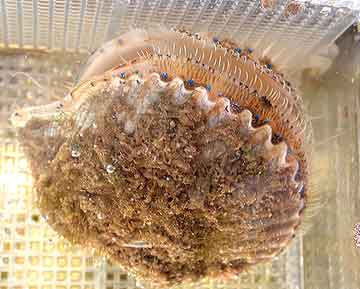

|
|
Biology Photo of the Month - January - February 2003Scallop eyesCommon Bay Scallop, Aequipecten irradians (from northern Gulf of Mexico)Text by Augsburg
biology student Natalie Lanzatella Update
- November 2003 |
||||||||||
 |
|
The
distinctive shape of scallop shells (with fin-like extensions
on each
side of the hinge), is familiar as the logo for a well-known oil company. |
|
|
Click photo for larger view (and see close-up at right) Scallops normally rest on the on the seafloor with shells partially open to allow water to be pumped past the gills for filter-feeding and gas exchange. |
Click photo for larger view Numerous fleshy tentacles extend from the mantle, looking like menacing teeth in this photo. These tentacles have sensory roles, helping to alert the scallop to danger that might warrant clapping the shells shut for protection, and they serve as a sort of sieve to prevent large particles from entering the mantle cavity (within which the delicate gills are exposed). |
|
Click
photo for MUCH larger view (256 KB)
The fleshy mantle that lines a scallop's
shells encloses an interior space (the mantle cavity), which houses
the gills (visible above) and the visceral mass. Microscopic beating
hairs (cilia) on the gills create water currents. Water flows through
the mantle cavity past the gills, bringing oxygen
to the gills as well as microscopic
food particles. Food particles captured on the gill surfaces are transported
by cilia to the mouth (the mouth is not visible when viewing a live
scallop).
See also: